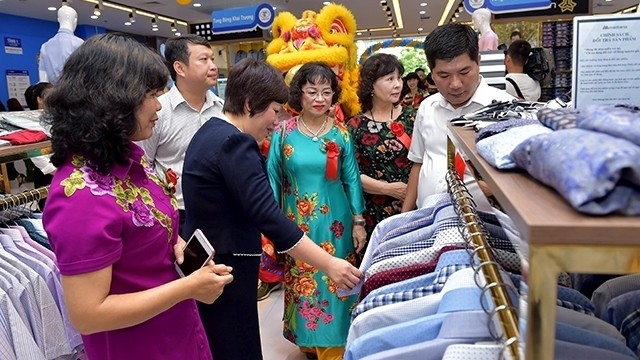Competing by difference
Deputy General Director of Duc Giang Garment Company (Dugaco), Pham Thanh Tung, could not conceal his pride when recalling how his company developed and introduced new products to local consumers.
In 2016, Dugaco established a fashion centre with a closed process from designing, making samples and manufacturing to distributing in order to make high-quality, competitively priced and original products.
In addition, the company has met the increasingly high demand of consumers with nearly 200 fashion outlets throughout the country featuring a wide variety of products.
Last April and June, the company unveiled a chain of suit shops with technology transferred from Sumikin that meets Japanese standards. With its quality and reputation, Dugaco has been selected by many organisations such as the State Treasury, the Hanoi People’s Court, Vingroup, Agribank and Vietinbank to make their office uniforms. Dugaco’s goal of generating more than VND500 billion (US$21.5 million) in domestic revenues in 2018 is within reach.
For Chien Thang Garment Company, after 20 years of making garment products for foreign brands, the company has now introduced its own fashion brand, Padu, with various products for both men and women, adults and children. For instance, its jackets have the same quality but their prices are just half of those exported to Europe.
Besides serving domestic consumers and exports, the Padu brand has demonstrated that Vietnamese garment companies could now become original design manufacturers and supply offerings to foreign brands with its own designs and products to increase the added value.
Retail network expansion
A number of subsidiaries of the Vietnam National Textile and Garment Group (Vinatex) such as Garment Co 10, Viet Tien and Nha Be have also increased investment and design efforts to introduce their own brands to the market.
Recently, Vinatex opened a six-storey fashion centre in Hanoi with a total area of more than 2,500 square metres, featuring products from Vietnam’s famous brands. After two months, the company’s revenues reached VND19 billion.
The opening of the Vinatex fashion centre reflects the group’s determination to occupy the domestic market. According to the Vietnam Textile & Apparel Association (Vitas), spending on garment products currently accounts for 5-6% of Vietnamese consumers’ total spending, equivalent to US$3.5-4 billion, indicating that the market holds great potential for domestic enterprises.
However, it is currently nearly impossible for domestic companies to raise their market share from 10% to 30% because the market is still flooded with smuggled and counterfeit products, many of which are branded as Vietnamese and designer products to fool consumers.
A Garment Co 10 representative stated that the company has opened a range of fashion centres with the principles: European fashion, Japanese technology, US convenience and Vietnamese prices. Besides maintaining more than 200 shops and dealers throughout the country, Garment Co 10 is also upgrading and expanding its fashion centres that cover 200-300 square metres with hundreds of new models to meet consumers’ demands.
Other companies such as Viet Tien, Nha Be and Viet Thang also have their own plans to expand their domestic retail network in order to increase their market shares.
According to Vinatex leaders, most companies only focus on developing stores in major towns and cities without adequate attention to the rural market. Therefore, the group has instructed its members to research and create product lines to satisfy the tastes of rural consumers.
Despite their strength in making export products and being the world’s third largest garment exporter, Vietnamese garment companies have yet to tap into the domestic market as expected.
In order to do so, Vietnamese garment makers need to renovate their management methods and equipment while ensuring the quality and affordable prices of their products. They also need to focus on designs, building brands and expanding the retail network in order to increase their competitiveness and capture the domestic market share.
















